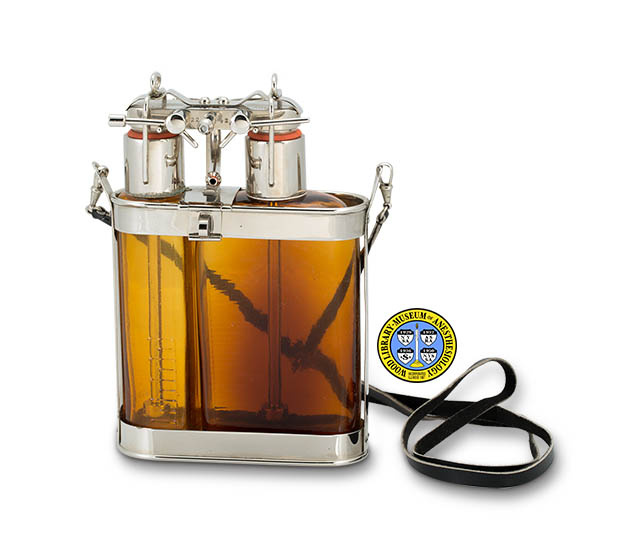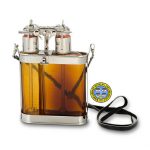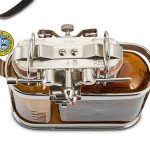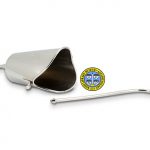Braun Narko Inhaler
German surgeon Heinrich F. W. Braun, M.D. (1862-1934) described his elegant ether-and-chloroform inhaler in 1901. Called the Narko Apparatus, the inhaler was manufactured by C. G. Heynemann, in Leipzig, Germany. Since the 1860s, anesthesiologists had sought to increase the safety of chloroform by combining it with less potent drugs, such as alcohol and ether. This practice was later abandoned.
The apparatus used the "blow-over" principle, pushing air over the liquid anesthetics through a hand-pumped rubber bellows. It was equipped with both a mask and a long metal tube that could be inserted into the pharynx (the opening at the back of the throat), for insufflation anesthesia. These were attached by rubber tubes; the example shown here lacks the rubber parts.
Dr. Braun is best known for his work in local and regional anesthesia. In 1903 he introduced the use of epinephrine for resuscitation, and as an adjunct to local anesthetics. He was one of the first to use Novocain as a local anesthetic. His textbook on regional anesthesia was published fifteen years before Gaston Labat, M.D. (1876-1934) brought the technique to the United States.
Catalog Record: Braun Narko Inhaler Braun Narko
Access Key: aqsk
Accession No.: 2016-05-20-1
Title: [Narko / designed by Heinrich Braun].
Author: Braun, Heinrich, 1862-1934.
Title variation: Alt Title
Title: Narko Apparat zur Aether-Chloroform-Mischnarkose.
Publisher: Leipzig, Germany : C. G. Heynemann, [between 1901 and ca. 1940].
Physical Description: 1 inhaler : glass, metals (chrome?), leather , rubber; 67.5 x 6 x 53.5 cm.
Subject: Anesthesia, Inhalation – instrumentation.
Subject: Chloroform – administration & dosage.
Subject: Ether, Ethyl.
Subject: Inhalers, Anesthesia.
Note Type: General
Notes: The title is taken from the manufacturer’s instruction booklet that accompanied the object.
The first year in the range of possible dates of manufacture is the date of introduction. The second year in the date is based on a Medicinisches Waarenhaus catalog that bears no publication date; the style and contents of this catalog suggest to the cataloger that it was issued in the 1930s.
Described from the patient’s point of view. The connectors for the mask and insufflation tube extend from this side. In this orientation, the user would see the marks on the top of the vaporizing head either from the back or from the side.
Heinrich Braun mentioned the B. Braun pharmaceutical company in some of his writings. The cataloger found no other connection between the two.
Note Type: With
Notes: Wooden case with hinged lid, two hook clasps and metal handle. The case measures approximately 21.5 centimeters in height with the lid closed and the handle folded down. The closed height with the handle standing upright is approximately 25 centimeters. The height with the lid standing fully upright is approximately 28 centimeters. The width is approximately 23.5 centimeters. The depth with the lid closed is approximately 10.5 centimeters. The depth with the lid open and folded back is approximately 21 centimeters. A metal label plate on the front of the case reads: “[Logo] [new line] C. G. HEYNEMANN [new line] Fabrik arztlicher Jnstrumente [sic] [new line] LEIPZIG”.
Note Type: With
Notes: Metal (chrome?) cone-shaped mask with a round air-intake hole on the back of the dome, and an L-shaped tube rising from the center of the dome; this tube extends a few centimeters inside the mask. The proximal edge is smooth and scalloped, with a much deeper scallop in front to accommodate the patient’s nose. Two hooks (perhaps for the attachment of a harness) are soldered above the proximal edge, one in front and the other in back; both hooks are stamped with the Heynemann logo (the letters “CGH” inside a shield).
Note Type: With
Notes: Metal (chrome?) insufflation tube, approximately 18 centimeters long. The proximal end is bent at nearly a right angle to the shaft.
Note Type: Citation
Notes: Braun H. Ueber michnarkosen und deren rationelle verwendung. Archiv für Klinische Chirurgie. 1901; 64(1):201-233.
Note Type: Citation
Notes: Braun H. Die Lokalanästhesie, ihre Wissenschaftlichen Grundlagen und Praktische Anwendung : ein Hand-und Lehrbuch. Leipzig : J. A. Barth, 1907.
Note Type: Citation
Notes: Braun H, Harris ML, trans. Local Anesthesia: its Scientific Basis and Practical Use. Philadelphia ; New York: Lea & Febiger, 1924.
Note Type: Citation
Notes: Gebrauchsanweisung Narko Apparat zur Aether-Chloroform-Mischnarkose nach Geh. Med.-Rat. Prof. H. Braun. Leipzig : C. G. Heynemann. [Translation: “Instructions for use”.] Accession File # 2016-05-20-1. Located at: Wood Library-Museum of Anesthesiology, Schaumburg, Illinois.
Note Type: Citation
Notes: Levy AG. The exciting causes of ventricular fibrillation in animals under chloroform anaesthesia. Heart. June 14, 1913;4: 319-379.
Note Type: Citation
Notes: Medicinisches Waarenhaus. Katalog A, Instrumentatium. Berlin: Medicinisches Waarenhaus Actien-Gesellschaft, date unknown:7.
Note Type: Citation
Notes: Rose W. Heinrich Braun (1862-1934): a German pioneer in anaesthesia. In: Atkinson RS, Boulton TB, eds. The History of Anaesthesia [proceedings of the Second International Symposium on the history of anaesthesia]. London ; New York: Royal Society of Medicine Services ; Carnforth, Lancs., U.K. ; Park Ridge, N.J., U.S.A. : Parthenon Pub. Group, ca. 1988.
Note Type: Citation
Notes: Science Museum, London, website. Braun ether and chloroform inhaler page. https://collection.sciencemuseum.org.uk/objects/co75641/braun-ether-and-chloroform-inhaler-inhaler. Accessed February 26, 2018.
Note Type: Physical Description
Notes: One inhaler; Consists of two amber glass bottles or flasks held in a metal (chrome?) frame; Each bottle is flat on the front, back, and one side; Each bottle has graduation lines on the front side; The smaller bottle on the left is meant to hold chloroform; This chloroform bottle is rounded on its left side and flat on its right side; The larger bottle on the on the right is meant to hold ether; This ether bottle is flat on its left side and rounded on its right side; The frame consists of two horizontal and two vertical metal bands; The top end of each of the vertical bands forms a metal tab to which one end of the strap is attached by a metal fastener;
A metal vaporizing component (or head) connects to both bottles at the top of the device; The neck of each bottle has a metal sheath; That on the left is marked “C” and that on the right is marked “A”; Each of these sheaths has a rubber gasket and a clip that holds the head firmly in place; When these clips are loosened, the entire head can be removed; The head holds two uptake tubes; When the head is attached, that tube on the left descends into the chloroform bottle and that tube on the right descends into the ether bottle; The head is marked on the top: “Narko [new line] Chlor. [arrow] [“CGH” logo] Aeth”; The arrow points toward the word “Narko”;
Two connecting tubes, one above the other, extend from the vaporizing head toward the patient; These connectors are flanked by delicate metal levers, one to the left and one to the right, that control the concentration of vapor; The head is marked on the front: “22 42”; The back of the head holds a hook that is attached by a screw;
A thin, black leather strap is attached to the frame of the apparatus; The height given in the short description is that with the strap at full extension above the unit, as it might be when suspended vertically; The height of the object without the strap is approximately 18.5 centimeters; The width given in the short description is that with the strap extended, either to the left or the right; The width of the object without the strap is approximately 15 centimeters; The accompanying metal mask and insufflation hook are parts included in the inventor’s published description.
Note Type: Reproduction
Notes: Photographed by Mr. Steve Donisch, January 16, 2018.
Note Type: Historical
Notes: German surgeon Heinrich F. W. Braun, M.D. (1862-1934) described his elegant ether-and-chloroform inhaler in 1901. Called the “Narko Apparatus”, the inhaler was made by the surgical instrument firm C. G. Heynemann, in Leipzig, Germany. The use of mixed inhalation anesthetics was first proposed in the 1860s. By combining it with other agents, such as ether and alcohol, physicians sought to slow the rate of vaporization and increase patient safety. Decades of research ultimately led anesthesiologists to abandon chloroform for inhalation anesthesia.
Braun’s apparatus used the “blow-over” principle, pushing air over the liquid anesthetics by means of a hand-pumped rubber bellows. As an alternative to the mask, the inhaler was also equipped with a long metal tube that could be inserted into the pharynx (the opening at the back of the throat), to administer insufflation anesthesia. Both the mask and the insufflation tube would have been attached to the inhaler by means of rubber tubes. The cataloged object lacks these rubber parts.
Dr. Braun is best known for his work in local and regional anesthesia. In 1897 he introduced a popular spinal syringe of his own design. In 1903, he introduced the use of the central nervous system stimulant and vasoconstrictor, adrenaline, as an adjunct to local anesthetics and for resuscitation. He was one of the first to use procaine hydrochloride (Novocain) as a local anesthetic. He also wrote an influential textbook on regional anesthesia. The first edition was published in 1905, more than a decade before Gaston Labat, M.D. (1876-1934) brought the technique to the United States.
Note Type: Publication
Notes: Braun H. Munchener medicinischewWochenschrift. May 14, 1901.
Note Type: Publication
Notes: Braun H. Zur aether-chloroform-mischnarkose. Zentralblatt für Chirurgie. April 4, 1903. 14:377-380.
Note Type: Publication
Notes: Braun H. Ueber einige neue örtliche anaesthetica (Stovain, Alypin, Novocain). DMW-Deutsche Medizinische Wochenschrift. 1905;31(42:1667-1671.
Note Type: Exhibition
Notes: Selected for the WLM website.




